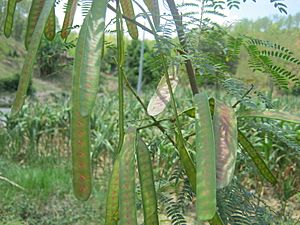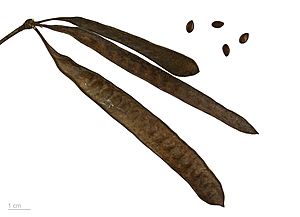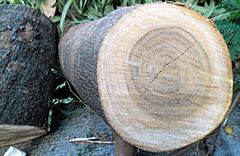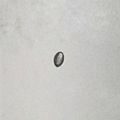Leucaena leucocephala facts for kids
Quick facts for kids Leucaena leucocephala |
|
|---|---|
 |
|
| Scientific classification | |
| Genus: |
Leucaena
|
| Species: |
leucocephala
|
| Synonyms | |
|
|
Leucaena leucocephala is a small, fast-growing tree that comes from southern Mexico and northern Central America. It is now found all over tropical areas, including parts of Asia.
This tree has many common names. Some people call it jumbay, pearl wattle, white leadtree, river tamarind, ipil-ipil, tan tan, or white popinac.
Leucaena leucocephala is used for many different things. People use it for fencing, to make soil healthier, as firewood, for fibers, and as food for livestock.
Contents
How Humans Use This Tree
In the 1970s and 1980s, this tree was called a "miracle tree" because it had so many uses. However, it can also spread like a weed in some places. This has led some to call it a "conflict tree."
The tree is very popular in several countries in Southeast Asia. These include Myanmar, Cambodia, Laos, and Thailand. It is mainly used there as good quality animal feed. It also provides wood for firewood or charcoal.
Food for Animals
This tree is a great source of high-protein food for cattle. However, it contains a harmful substance called mimosine. Horses and donkeys that eat too much of it can lose their hair.
In many places, special bacteria in the stomachs of animals like cows can break down mimosine. But in some areas, animals don't have these bacteria. When this happens, the tree can be harmful to them.
Scientists have found ways to help these animals. They can give the animals the special bacteria from other animals. This has made it possible to use Leucaena as animal food in places like Australia.
Helping Soil and Making Energy
Leucaena leucocephala is also good for making biomass. This means it can produce a lot of plant material. Its leaves can yield up to 20,000 kg per hectare each year. The wood can grow up to 40 cubic meters per hectare annually. In good climates, these amounts can be even higher. India uses this tree for both animal food and energy.
The tree is also very good at nitrogen fixation. This process adds nitrogen to the soil, which helps other plants grow. It can add over 500 kg of nitrogen per hectare each year.
It grows very quickly. Young trees can reach more than 20 feet tall in just two to three years.
Food for People
The young pods of this tree are safe to eat. In Indonesia, they are sometimes added to a vegetable salad called Pecel. They are also used in a spicy fish dish wrapped in leaves called Buntil.
In Laos and Thailand, the pods are known as phak krathin. They are often used in papaya salad. In Mexico, the pods are called guaje and are eaten in soups and tacos. The Mexican state of Oaxaca even got its name from the Nahuatl word huaxyacac. This was the name for the Leucaena leucocephala trees found around Oaxaca City.
Making Paper
Recently, the wood from this tree, also called Subabul, has been used to make pulp for the pulp and paper industry. In southern and central India, Subabul is a very important tree for making paper pulp.
Growing Subabul has greatly helped small farmers in these areas. It gives them another crop choice besides cotton and chilies. This has a big positive impact on their lives.
Why This Tree Can Be a Problem
Leucaena leucocephala is considered one of the 100 worst invasive species by a group called the IUCN Species Survival Commission. An invasive species is a plant or animal that spreads quickly and harms the local environment.
This tree is highly invasive in many places. These include dry parts of Taiwan, The Bahamas, the Hawaiian Islands, Fiji, Puerto Rico, Hong Kong, South Africa, and northern Australia. It is also found in South America and Europe. In the U.S., it grows in California, Arizona, Texas, and Florida.
It grows very fast and forms thick groups of trees. These thickets can push out all the plants that naturally grow in an area. In cities, it is often seen growing along dry roadsides, in parking lots, and on empty land.
Other Challenges with This Tree
This tree can be easily attacked by insects. In the 1980s, many Leucaena trees in Southeast Asia were lost because of tiny insects called psyllids.
In India, this tree was first planted a lot because it grows so fast. However, it is now thought to be not good for planting in cities. This is because its roots are not very strong, and it can easily fall over in rain and wind. In the city of Pune, eight out of every ten trees that fall over in the wind are L. leucocephala.
The seeds of this tree contain mimosine. This is a substance that can be toxic to animals that are not ruminants (like cows or sheep).
Gallery
-
Sapling of Leucaena leucocephala. The cotyledons are visible.
-
Subabul growing wild on the outskirts of Mumbai
See also
 In Spanish: Huaxyacac para niños
In Spanish: Huaxyacac para niños










